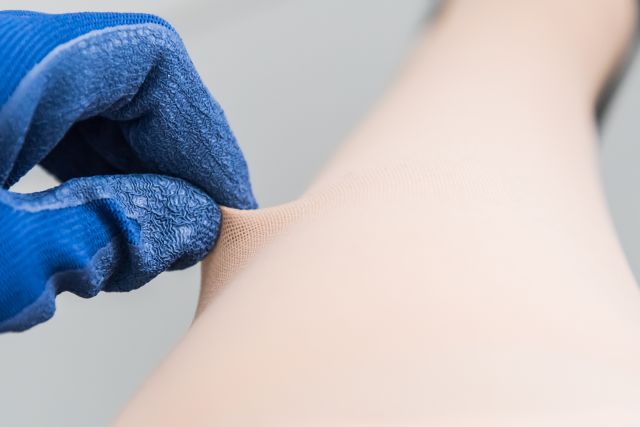Graves’ disease is an autoimmune disorder where the body’s immune system attacks the hormone-producing thyroid gland. This causes the gland to produce excess amounts of thyroid hormone, a condition known as hyperthyroidism. Graves’ disease is the most common cause of hyperthyroidism.
Normal levels of thyroid hormone are essential to the normal functioning of nearly every major organ and system in the body, including the skin.
What is thyroid dermopathy?
The term dermopathy refers to a disease of the skin, and thyroid dermopathy is a skin condition that can affect people who have Graves’ disease (as well as other thyroid disorders). Thyroid dermopathy is also known by several different names—Graves’ dermopathy, localized myxedema, infiltrative dermopathy, and pretibial myxedema—which you may come across while reading about Graves’ disease or Graves’ dermopathy.
What are the symptoms?
The part of the body most commonly affected by Graves’ dermopathy is the skin in front of the shin bones. However, symptoms also occur on the ankles, feet, knees, and calves. Symptoms can also appear on other parts of the body, and symptoms are common in places where the skin has been injured in the past.
Affected areas of the skin may have the following symptoms:
- Swelling that causes the skin to look and feel larger, or shoes or clothing to fit more tightly.
- Firm round or tube-like lumps under the skin (called nodules).
- Plaques, where areas of the skin become thickened, raised, and scaly.
- Changes to the skin texture, sometimes described as the skin having an “orange peel” texture. This is caused by hair follicles becoming more prominent.
- Changes to the color of the skin. For example, the skin may become yellowish or have a reddish or purplish tinge.
- Increased sweating and/or increased hair growth.
These symptoms may be sore or itchy but are typically not painful. They may also be accompanied by swelling and/or clubbing of the fingers and toes (a condition called thyroid acropachy).
In rare cases, thyroid dermopathy can cause elephantiasis—severe and debilitating swelling and thickening of the skin and tissues underneath the skin. This is referred to as the elephantiasic form of thyroid dermopathy. It’s caused by a buildup of lymph—the fluid that flows through the lymphatic system and circulates immune cells throughout the body.
What causes thyroid dermopathy?
These symptoms are caused by the accumulation of compounds called glycosaminoglycans (GAGs) in the layers of the skin. GAGs are found in all tissues throughout the human body (and the bodies of other mammals). These compounds play a part in many different functions—communication between different cells, cell growth and repair, wound healing. It is not known exactly why deposits of GAGs accumulate in the skin of some people who have thyroid disorders, and more research is needed.
How is thyroid dermopathy treated?
In many cases, thyroid dermopathy may not require treatment other than the treatment for Graves’ disease (or the other thyroid disorder that caused thyroid dermopathy). Your healthcare provider might prescribe topical steroids and recommend that you wear compression stockings. For more severe cases, your healthcare provider may prescribe corticosteroids that are given as injections, or a medication that improves blood flow. Medications must always be used under the guidance of a healthcare provider.
How common is thyroid dermopathy?
Most people who have thyroid dermopathy have another condition called thyroid eye disease (TED).
With TED, an autoimmune attack causes inflammation and damage in the muscles and fatty tissues that surround the eyes. One of the most recognizable symptoms of TED is eyeballs that bulge or protrude, as they are pushed forward by inflamed tissue. TED can cause the eyes to become irritated and damaged—and in some cases, it can cause vision changes and vision loss. Only a small percentage of people who have TED have thyroid dermopathy.
Thyroid dermopathy may not be a common manifestation of Graves’ disease. But the fact that it can and does occur highlights the fact that thyroid disorders are different experiences for different people—and if you are living with a thyroid disorder, it’s important that you always tell your healthcare providers about any new symptoms and any changes in symptoms.






